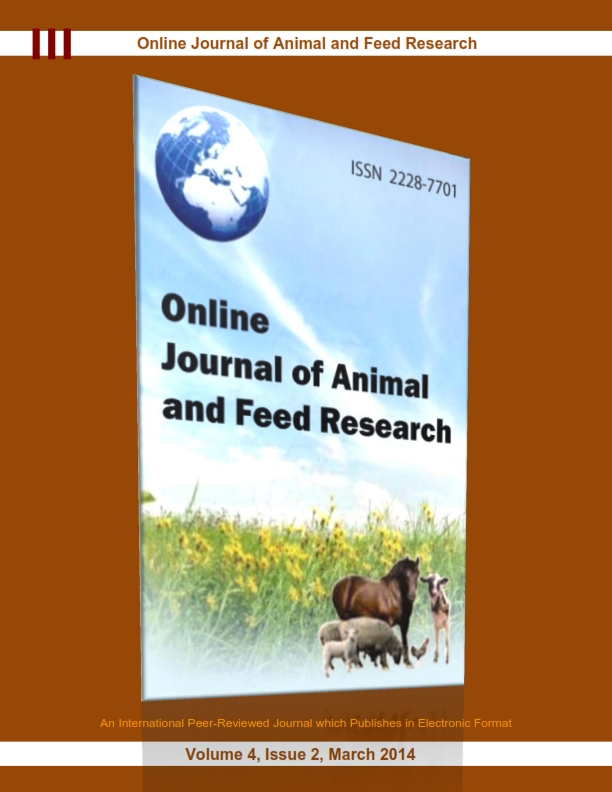|
pii: S222877011400005-4
Supplementing probiotics (Saccharomyces cerevisiae) in multiparous crossbred cows ration provoke milk yield and composition

|
Original Research, D5
Hossain FMA, Islam MM, Ara A, Iliyas N.
Online J. Anim. Feed Res., 4(2): 18-24, 2014.
ABSTRACT: Ten multiparous cows were selected to determine the effect of probiotics (Saccharomyces cerevisiae) on milk yield and composition. These cows were taken as control group before feeding probiotics and after feeding they were taken as treatment group. The cows were supplemented with 15g live yeast culture per head per day for a one month trial period. In the conducted experiment it was seen that there was significant (P<0.05) improvement in milk yield after supplementing probiotics (0.3 liter/ day/ animal which is 8.8% in average daily milk yield) to the cross breed dairy cows. It was observed that there was no significant improvement in butter fat percentage of milk (P>0.05) and acidity (%) between treatment group and control group, but significant improvement (P<0.05) was found in protein content and solids-not-fat content of milk.
Keywords: Crossbred Cows, Milk Yield, Milk Composition, Probiotics, Saccharomyces cerevisiae
|


|
|
pii: S222877011400006-4
Proximate analysis and anti-nutritional factors of groundnut and melon husk


|
Original Research, D6
Abdulrazak S., Otie D., Oniwapele Y.A.
Online J. Anim. Feed Res., 4(2): 25-28, 2014.
ABSTRACT: Groundnut and Melon husks (shell) were collected from the market side in Kaduna metropolis, Kaduna State and milled into powder for proximate and anti-nutritional analysis. The results of proximate analysis showed that groundnut shell contained moisture content, ash content, crude fibre, lipid, crude protein, carbohydrate, oxalate, phytate, cyanogenic glycosides and trypsin inhibitor are 8.0%, 2.50%, 59.0%, 0.50%, 4.43%, 25.57%, 220mg/100g, 362.1mg/100g, 1.60mg/100g, and 25 TUI/mg respectively while melon shells contained 7.50%, 6.50%, 51.50%, 11.90%, 4.68%, 17.92%,132mg/100g, 62mg/100g,0.50 and 60 TUI/mg. These two agricultural wastes were found to have high nutritive values and low anti-nutritive values and can be used as an alternative source of animal feeds for herbivores and also solve a waste disposal problem and helping in turning waste into a wealth.
Keywords: Groundnut Husk, Melon Husk, Proximate Analysis, Anti-Nutritional Factors And Animal Feeds
|


|
|
pii: S222877011400007-4
Choice and pattern of therapeutic antimicrobials in companion animals (dogs, cats and birds) in Aba, Abia state, Nigeria

|
Original Research, D7
Nwiyi, P.
Online J. Anim. Feed Res., 4(2): 29-31, 2014.
ABSTRACT: The choice and pattern of therapeutic antimicrobials were evaluated in companion animals. This was carried out by visiting the clinics and verifying the records of the pharmacy unit of the ten veterinary clinics and poultry services located within Aba, Abia State. Simple random sampling was used in selecting the clinics for this study. For the purpose of this study, a bird was used to represent a poultry farm. A total of 1961 companion animals made up of 1468 dogs, 172 cats and 321 birds (poultry farms). This study arises due to the need to avoid possibility of build-up of multi-drug resistance as a result of excessive drug usage and to know the choice antimicrobial currently in use. From the study, the choice antimicrobials use for dogs was Amoxicillin, for cat was Duxipra while Enrofloxacin was for birds, the percentage usage was represented as 45%, 50% and 40% in that order.
Keywords: Antimicrobial resistance, Dog, Cat, Birds
|


|
|
pii: S222877011400008-4
Quantification of browse in rangelands

|
Original Research, D8
Kagande SM.
Online J. Anim. Feed Res., 4(2): 32-36, 2014.
ABSTRACT: A study was conducted in the rangelands of three selected villages of Mupfurudzi resettlement area in Zimbabwe. The objective of the study was to quantify the browse in the resettlement area rangelands by calculating the total potential browsable units. The rangeland in each village were delineated by physiognomic cover type strata namely a vlei, a tree bush savanna, a bush savanna depending on the vegetation type. Within each village, a belt transect measuring 100m long and 2m wide was laid at random to further divide the rangeland into manageable units which are representative of the whole veld type. Within each transect the following dimensions were measured on all woody plant species by visual estimation: (a) the veld type unit where the transect was laid (b) the transect number (c) the plant species (d) the plant height from the ground (e) the height of the canopy bottom from ground level (f) the canopy radius and (g) palatability of the plant species. It was found that veld type unit had a significant effect on browse units (P< 0.05). The effect of village on the browse unit was not significant but however, the effect of the interaction between village and veld type unit was significant (P< 0.05). Browse units in veld type units showed that the bush savanna was significantly different from the vlei. The average browse units in all the selected villages of Mupfurudzi were 1324 browse units/hectare of land.
Keywords: Browse palatability, Physiognomic cover type, Veld type unit
|


|



